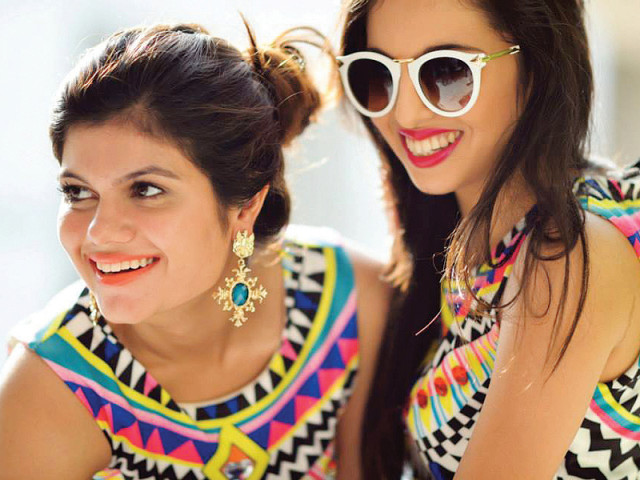Sartorial Word: Mantra for the trendsetting
Apart from Western wear, the store stocks stylish Eastern wear as well.

Apart from Western wear, the store stocks stylish Eastern wear as well.
Amongst the assorted coterie of designer ready-to-wear that is now available at Karachi’s colossal Dolmen City Mall — with clothes varying from the horrendous to the absolutely gorgeous — there’s a window display that always catches my eye. Mannequins in easy-breezy beach wear with coconuts tossed around their feet, bird cages tossed around a floral spring line and a very on-trend black and white collection taking centre stage at the entrance. For as long as I can remember, the mannequins at Mantra have preferred to make style statements rather than just stand complacently.
This is one of the main reasons why the shop has always managed to hold its own in malls where it stands neck-and-neck alongside local and international designer hotshots. Mantra’s Dolmen City outlet is right next to the uber-popular Khaadi and the shop in Park Towers has international brand Next to contend with. But that window display — psychedelic, eye-catching, putting together chic looks that showcase the best of what’s inside the shop — hardly ever fails. And once you’re inside the shop, there’s a good chance you’ll get hooked.

Tunics, jumpsuits and dresses hang alongside pants, jeggings and the very much in demand printed jersey leggings; florals mix in with neons, whites and classic black and white; chunky gold rivets, quirky tees and wild prints; knuckle-dusters, beautiful neon clutches, platform shoes and statement jewelry, mostly priced around Rs5,000 — this is one cost-effective store for the young, the fashion-savvy and for the many Page 3 celebrities that one sees wearing Mantra at events. It’s like a walk down a mall in Bangkok, one without the tacky side-stalls, stocked with a keen, discerning eye on international trends.
“Most of our stock is from the Far East,” agrees Mantra’s Creative Director Soha Hafeez. “But a lot of the jewelry is Australian and there are some items sourced from Europe and USA — there are things here from all over the world!”
The job, then, of traveling ‘all over the world’ falls upon Soha, who makes umpteen trips abroad to select and bring back stock for the brand’s three stores — two in Karachi and another, which is currently being relocated in Islamabad. Is that like a massive, all-paid shopping trip where she roams malls and just picks up what she likes?, I ask her. Apparently, yes, but it isn’t as much fun as it sounds. “I do go to malls but a lot of my work also involves meeting up with agents, checking the quality of products, whether the fabric would work well in Pakistan and then ordering what I like,” says Soha. “We draw up extensive trend forecasts at Mantra and when I shop for the store, I often try to follow the trends and colour schemes that we had identified earlier.”
Once she’s back home, there’s the tedious task of sorting, itemising and figuring out the best way to visually merchandise the products — the window displays are all Soha’s handiwork. “It’s important to stock things in a way that different separates complement each other,” says Soha. “It’s much better to hang particular pant styles next to tunics that would look good on them. Customers often prefer to buy into entire looks rather than just separates.”

It’s simple clever retail. Flashback to 2003, when the brand started out, and the shop did not know any better than to stow its pants on one side and tunics on the other. It’s taken time — and a succession of talented creative directors — for the benefits of visual merchandising to seep in. Maliha Chaudhary, now the brains behind ready-to-wear brand Daaman, handled Mantra in its earlier years and stylist Maha Burney was the creative director back in 2010, when the brand began to reach out through social media. “From about 20,000 fans back then, Mantra now has over 100,000 fans,” says Maha. “Facebook and Instagram are a very effective way of advertising what’s in store and figuring out the items that are more in demand.”
One of these hot-selling items are Mantra’s printed jersey leggings, that are now produced in-house rather than sourced from abroad. “As the brand has expanded, we have observed that many of our shoppers are also interested in buying Eastern wear,” explains Soha. “To this end, we have set up a manufacturing unit — for production of in-demand items such as leggings and our East-meets-West fusion line.”
Thankfully, unlike most brands, Mantra’s ‘Eastern-wear’ doesn’t equate to hackneyed embroideries, A-line shirts and voluminous dupattas. The tunics are there, but a lot of them are in silk print and refreshingly short; there are cotton scarves instead of dupattas. Some women — the lawn-loving ones come to mind — may not find them conventionally formal, but trussed up, they can easily be translated into evening-wear. It’s a lesson for the myriad designer brands that are slipping by following routine silhouettes that sell well but lack imagination. Mantra’s separates are certainly a par above — and why look like all the other A-line wearing women in the room when you can wield your own individualistic ‘mantra’?
Maliha Rehman is a fashion and lifestyle journalist with an obsessive, compulsive need to write. Log on for more updates on Twitter @maliharehman
Published in The Express Tribune, September 9th, 2013.
Like Life & Style on Facebook, follow @ETLifeandStyle on Twitter for the latest in fashion, gossip and entertainment.



















COMMENTS
Comments are moderated and generally will be posted if they are on-topic and not abusive.
For more information, please see our Comments FAQ